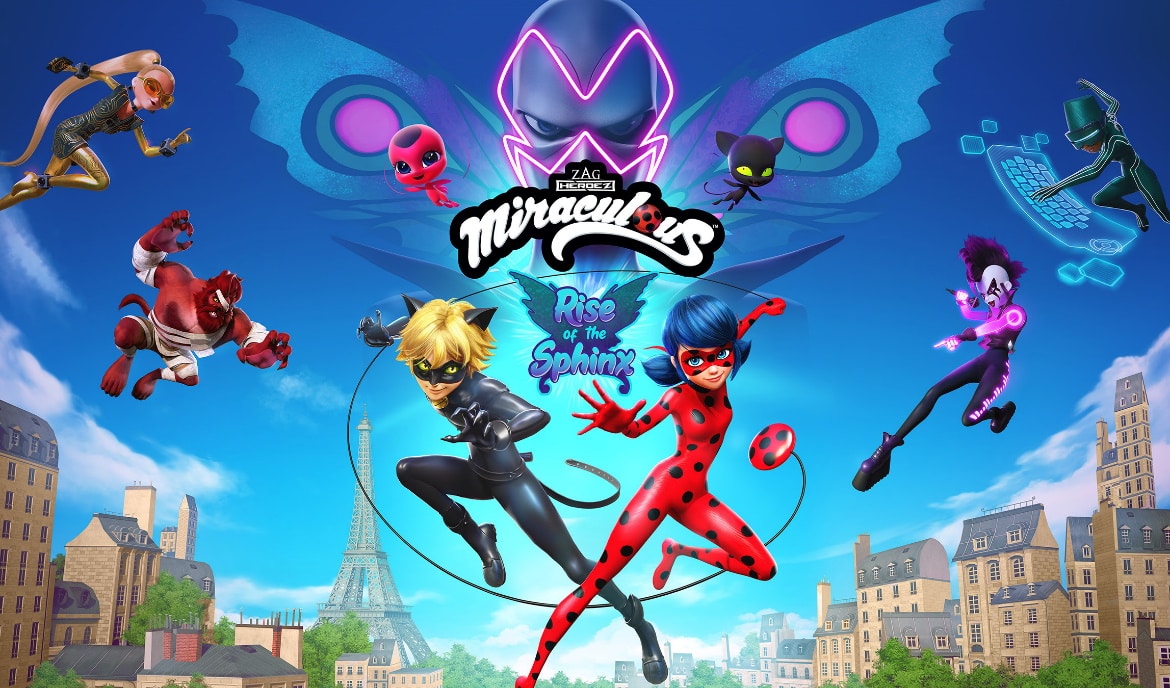The French-born animated series Miraculous: Tales of Ladybug & Cat Noir has become something of a hit among children since its debut in 2015. Toys and clothing have flown off the shelves and a stage musical, feature film and even a manga are in the works. Naturally, the popular children’s show has now been adapted into a video game in the form of Miraculous: Rise of the Sphinx.
Young players assume the roles of Ladybug and Cat Noir either solo or co-operatively, able to freely switch between the two if playing alone. The diabolical Hawk Moth has devised a devious plot, one that can only be stopped by the superhero duo and their suite of gadgets and abilities. Exploring Paris in between the main story quests as the heroes behind the masks of Ladybug and Cat Noir, as Marinette and Adrien respectively, keeps the adventure varied and faithful to the happenings of the animated series. Paris needs a hero to be strong, be brave… and be Miraculous!
Miraculous: Rise of the Sphinx is a 3D platforming adventure with a light combat system, simple puzzle solving and shallow exploration. The brief three-to-four-hour adventure takes players across Paris to thwart the dastardly plans of the villain Hawk Moth and the minions he has dispatched to stop the superhero pair. There is little no explanation for most of what is happening and who the characters, nearly immediately requiring players to be familiar with the animated series the title has been adapted from for this original story. While this won’t be an issue for young players who have seen the show, new players and especially older ones are missing a lot of key context that explains what the key gadgets do and why they are so fundamental to the plot. This is never more evident than in a late-game boss encounter that is easily the worst handling of a boss battle, checkpoint system and requirement of prior knowledge that I have ever experienced. More on this later.
Playing as the heroes without their suits is a nice touch, giving players a window into the characters behind the masks that places a heavy emphasis on not just their relationship but also with their other high school classmates. Miraculous: Rise of the Sphinx does a commendable job in regard tohumanising the heroes and keeping the adventure rooted in the teenage dramas of love, jealousy and rumours, battles even a superhero can struggle with.

Friendship levels with each of the handful of interactable characters can be increased by talking with them regularly outside of the main missions, though this serves no actual purpose towards the overall adventure but rather something to keep players busy while exploring the streets of Paris if they want to accomplish absolutely everything there is to do, particularly where Achievements are concerned.
The core gameplay sees players fighting bad guys, dodging their attacks and double jumping across the surprisingly serviceable platforming elements. Combat is sluggish and little more than a button mashing affair that tires very quickly. Players can dodge and parry though the simplicity of the combat encounters renders these actions unnecessary for the most part as the enemies can be quickly defeated by spamming attacks before they can even get a move in of their own.

Throughout the stages there are shiny blue orbs and coloured macarons to collect, these can be spent at Master Fu’s shop in the explorable Paris segments between the main missions. The orbs letplayers purchase upgrades for both Ladybug and Cat Noir and the macarons can be spent on artwork, the in-game music soundtracks and character models.

The platforming is easily the strongest aspect of the title and even though it’s simple, it’s accessible for the younger players it is targeted at. Jumping and double jumping to new heights or platforms is simple and the areas to land on are generous enough in terms of size to prevent tight landings or failure. The way the platforming compliments the unique art direction of the different stages is an absolute highlight.
One stage is focused on a sound-based villain, transforming this section of Paris to manifest large drum kits, guitars, pianos and vinyl records to traverse, including a variety of authentic sound effects that reflect the surface being crossed. This stage in particular is a lot of fun to see the different moving parts come together for a very cool and unique take on the traditional platforming elements one might expect.

Another example of fun art design incorporated into the gameplay is a stage built around paperwork and books, invoices and receipts that create bridges and interesting plateaus to navigate. Miraculous does an overall great job in keeping the environment exciting though it isn’t quite enough to make up for the shortcomings in its shallow, clunky combat.

Miraculous: Rise of the Sphinx includes boss battles to close out each of its missions and these mix things up a little bit by introducing different strategies to execute and attack patterns to observe and avoid. None of these are particularly difficult and work effectively to punctuate the brief missions with some variety to the subpar combat.
One stage though, as mentioned earlier, highlights some glaring issues. Instead of a traditional combat-based boss encounter, The Gamer encounter plays out like a game show where the player is presented with a question and has tochoose the correct answer from four possible choices. There are ten questions to get through and the player can only get two questions wrong before the encounter is failed. Failure means the player is reloaded to the previous checkpoint which includes an unskippable cutscene before being able to try again. The questions asked are from a larger pool so they may not be the same as the last attempt. What is incredibly frustrating is that these questions all require prior knowledge from the animated series, meaning a newcomer to the game with no knowledge of the show, such as myself, is potentially in for a very long and painful experience.

I had to resort to writing down the questions on my phone and recording every correct and incorrect answer, eventually leaving me with a list of guaranteed answers and a list of incorrect answers to avoid when trying those specific questions again. I spent over an hour of the four hours it took to finish the game on this. It’s unfair to newcomers to the Miraculous world, it’s painful to have to rewatch the unskippable cutscene before trying again after failure and it just does not belong in a children’s title.
Having played an extensive number of games aimed at kids either alone or with my own children, I have personally never seen a scenario like this that punishes it’s players for not being familiar with the source material. There will be some young players that possibly are unable to complete this encounter and therefore the game.

Having only watched a few episodes of the animated show after playing this game, I feel the presentation is pretty authentic. The charming art direction is well executed on a character level though the actual details in the environment are a little simplistic. The score is playful and upbeat, and the overall sound design does a decent job.
Dayne

